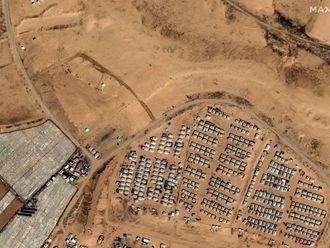
Cairo: Sudanese took to the streets in the capital of Khartoum and elsewhere across the country for mass protests Sunday against an October military takeover and a subsequent deal that reinstated Prime Minister Abdalla Hamdok.
The demonstrations mark the third anniversary of the uprising that eventually forced the military removal of longtime autocrat Omar Al Bashir and his Islamist government in April 2019.
Sudan then followed a fragile path toward democracy and ruled by a joint military-civilian government. The October 25 dissolution of government rattled the transition and led to relentless street protests.
Video footage circulated online purported to show protesters marching in the streets of Khartoum and its twin city of Omdurman on Sunday. Protesters were seen waving the Sudanese flag and white ones with printed images of those killed in the uprising and ensuing protests.
Ahead of the demonstrations, Sudan’s authorities tightened security across the capital, barricading government and military buildings to prevent protesters from reaching the military’s headquarters and the presidential palace. They also blocked major roads and bridges linking Khartoum and Omdurman across the Nile River.
Security forces used tear gas to disperse protesters headed toward the palace on the bank of the Blue Nile in the heart of Khartoum, according to activist Nazim Sirag. There were no immediate reports of causalities.
There were also protests in other cities including in Atbara, the birthplace of the uprising against al-Bashir.
The protests were called by the pro-democracy movement that led the uprising against Al Bashir and stuck a power-sharing deal with the generals in the months that followed his ouster.
Relations between the generals and the civilians in the transitional government were shaky and capped by the military’s October 25 takeover that removed Hamdok’s government.
Military oversight
Hamdok was reinstated last month amid international pressure in a deal that calls for an independent technocratic Cabinet under military oversight led by him. The agreement included the release of government officials and politicians detained since the takeover.
Talks are underway to agree on what Gen. Abdel-Fattah Burhan, head of the ruling Sovereign Council, described as a ‘new political charter’ focused on establishing a broader consensus among all political forces and movements.
Addressing Sudanese late Saturday ahead of the protests, Hamdok said he stuck the November 21 deal with the military mainly to prevent bloodshed. He warned that the country could slide further into chaos amid uphill economic and security challenges.
“Today, we are facing a retreat in the path of our revolution that threatens the country’s security and integrity,” Hamdok said, adding that the agreement was meant to preserve achievements his government made in the past two years, and to “protect our nation from sliding to a new international isolation”.
“The deal, in my view, is the most effective and inexpensive means to return to the course of civic and democratic transition,” he said.
Hamdok urged political parties and movements to agree on a “national charter” to complete the democratic transition and achieve peace with rebel groups.












